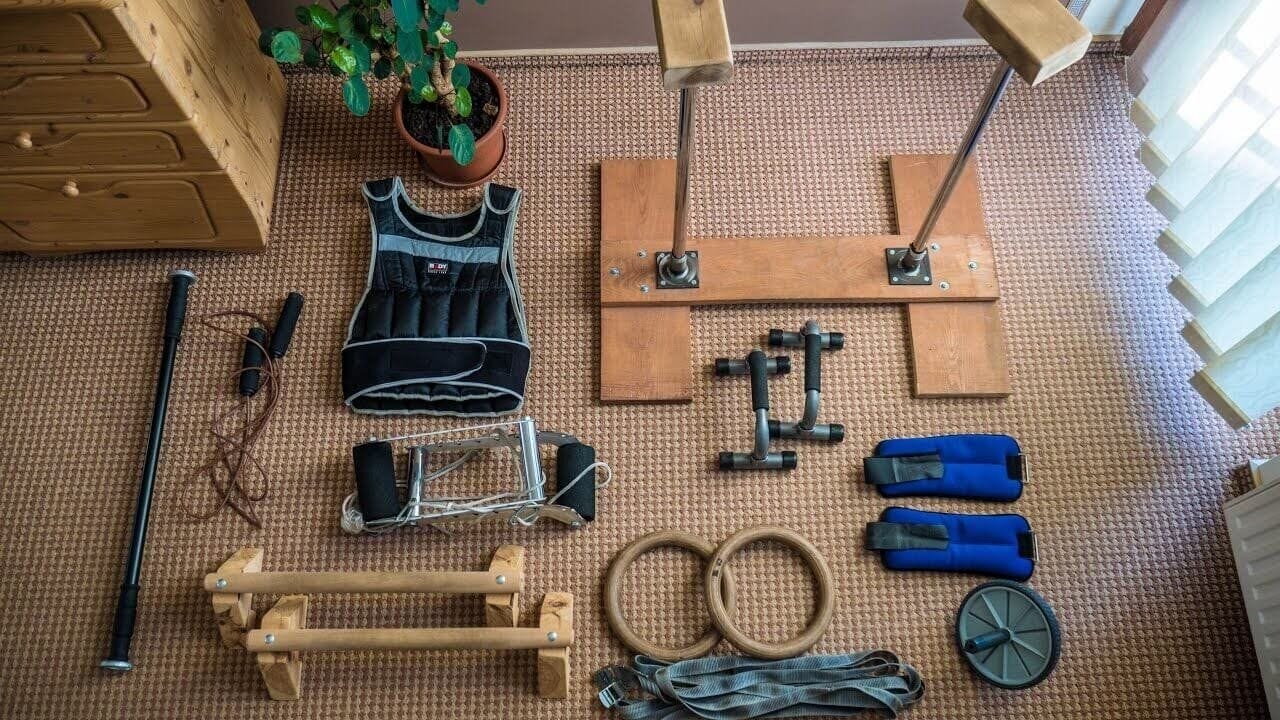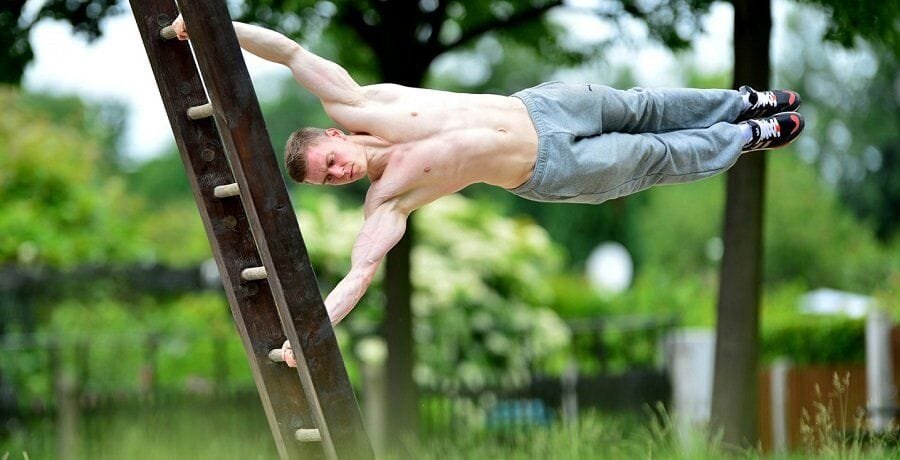If you’ve been searching for “how to start calisthenics” or “calisthenics workout for beginners,” you’ve likely encountered plenty of surface-level advice that leaves you with more questions than answers.
Most guides offer a quick one-week plan but fail to provide the fundamental knowledge you need to continue progressing beyond those initial workouts. That’s where this comprehensive guide differs.
I’ve spent over 5 years training and researching calisthenics, and I’ve created this resource to give you everything you need to not just start calisthenics, but to understand the principles behind it so you can create sustainable progress for years to come.
Whether you’re a complete beginner or someone looking to refine your approach to bodyweight training, this guide will walk you through every aspect of calisthenics from understanding the fundamentals to creating your own effective workout routine.
Table of Contents
Table of Contents
- What is Calisthenics?
- Benefits of Calisthenics Training
- Different Calisthenics Disciplines
- Essential Equipment for Beginners
- Understanding Exercise Progressions
- Mastering Scapula Positioning
- Beginner Calisthenics Workout Plan
- Common Beginner Mistakes to Avoid
- Nutrition for Calisthenics
- Tracking Progress and Setting Goals
- Essential Calisthenics Terminology
- Frequently Asked Questions
What is Calisthenics?

Calisthenics, derived from the Greek words “kalos” (beauty) and “sthenos” (strength), is a form of exercise that uses your own bodyweight as resistance rather than external weights or machines. Also known as bodyweight training or street workout, calisthenics focuses on developing strength, flexibility, agility, balance, coordination, and endurance through fundamental movement patterns.
Unlike traditional weightlifting that often isolates specific muscle groups, calisthenics typically involves compound movements that engage multiple muscle groups simultaneously, promoting functional strength that translates to everyday activities and athletic performance.
Is Calisthenics Right for You?
Before diving deeper, it’s important to determine if calisthenics aligns with your fitness goals. Calisthenics is excellent for:
- Building functional strength and muscle endurance
- Improving body control and awareness
- Developing impressive skills like muscle-ups, handstands, and human flags
- Training anywhere with minimal equipment
- Creating a sustainable fitness practice that scales with your abilities
However, if your primary goal is to maximize muscle size (hypertrophy), traditional weightlifting might be more efficient. That said, you can absolutely build muscle with calisthenics through proper programming and nutrition.
The most successful calisthenics practitioners find their own personal motivation for training. Whether it’s mastering impressive skills, improving overall fitness, or simply enjoying the freedom to train anywhere, identifying what excites you about calisthenics will keep you motivated long-term.
Benefits of Calisthenics Training
Calisthenics offers numerous advantages over other training methods:
Accessibility and Convenience
One of the greatest benefits of calisthenics is that you can practice almost anywhere with minimal equipment. Whether you’re at home, in a park, or traveling, you can always get a quality workout in without needing a gym membership.
Functional Strength Development
Calisthenics builds strength that directly translates to real-world activities. By mastering control of your own bodyweight through various planes of movement, you develop practical strength that helps with everyday tasks and athletic performance.
Improved Body Awareness
Bodyweight training requires a deep connection between mind and muscle. As you progress, you’ll develop enhanced proprioception (awareness of your body’s position in space) and better control over your movements.
Joint Health and Injury Prevention
When performed with proper form, calisthenics exercises are generally joint-friendly and can help build the stabilizing muscles that protect your joints. The progressive nature of calisthenics allows you to advance at a pace that’s appropriate for your body.
Skill Development
Unlike traditional weight training where progress is measured primarily by increasing weight, calisthenics offers the satisfaction of unlocking new skills and movements. This skill-based approach provides clear, tangible goals that keep training fresh and motivating.
Minimal Equipment Costs
Starting calisthenics requires significantly less financial investment than building a home gym or paying for a gym membership. A simple pull-up bar and perhaps a set of resistance bands are enough to begin an effective training program.
Different Calisthenics Disciplines
Calisthenics encompasses several distinct disciplines, each with its own focus and appeal. Finding which discipline resonates with you will help maintain your motivation and guide your training approach.
Static Holds (Isometrics)

Static holds involve maintaining a fixed position against gravity, requiring significant strength and control. Your muscles are working hard while remaining at a constant length.
Popular static holds include:
- Front lever
- Back lever
- Planche
- Human flag
- L-sit and V-sit
These impressive positions demonstrate pure strength-to-weight ratio and can take months or even years to master. The journey to achieving these holds builds tremendous upper body and core strength.
Freestyle Calisthenics (Bar Flow/Dynamics)
Freestyle calisthenics combines strength, power, and creativity to perform dynamic movements and transitions, primarily on bars. This discipline is featured in calisthenics competitions worldwide and emphasizes flow, momentum, and self-expression.
Common freestyle elements include:
- Bar spins and 360s
- Muscle-ups with variations
- Front and back flips from the bar
- Complex transition combinations
Freestyle calisthenics brings excitement and adrenaline to training but requires a solid foundation of strength and technique before attempting advanced moves.
Watch this video to get a taste of the different tricks you may learn in freestyle calisthenics.
Advanced Bodyweight Exercises
This discipline focuses on mastering challenging bodyweight exercises that require significant strength and skill. These movements serve as benchmarks for progress in calisthenics.
Popular advanced exercises include:
- Muscle-ups (bar and ring)
- One-arm pull-ups
- Handstand push-ups
- Pistol squats
- Dragon flags
The satisfaction of achieving these movements for the first time creates a powerful sense of accomplishment that keeps many practitioners motivated.
Hand Balancing/Handstands

Hand balancing focuses on developing the strength, balance, and body control necessary to perform handstands and their variations. This discipline requires consistent practice and patience.
Handstand progression typically includes:
- Wall handstands
- Freestanding handstands
- Press to handstand
- Handstand walking
- One-arm handstand
Many practitioners dedicate separate training sessions specifically to handstand work, as it complements other calisthenics training while developing unique skills.
Finding Your Path
You don’t need to limit yourself to just one discipline. Most calisthenics enthusiasts incorporate elements from multiple disciplines into their training. Experiment with different aspects of calisthenics to discover what excites you most, then set specific goals within those areas to maintain motivation.
Essential Equipment for Beginners

While calisthenics primarily uses your bodyweight, a few key pieces of equipment will significantly expand your exercise options and help you progress more effectively.
Must-Have Equipment
1. Pull-Up Bar
A pull-up bar is the single most important piece of equipment for calisthenics. It allows you to perform essential pulling exercises that are otherwise difficult to replicate. Options include:
- Doorway pull-up bars (most affordable and space-efficient)
- Wall-mounted pull-up bars (more stable for advanced movements)
- Free-standing pull-up stations (no installation required but takes up more space)
Check out our guide to choosing the best pull-up bar for your needs.
2. Resistance Bands
Resistance bands are incredibly versatile and serve multiple purposes in calisthenics:
- Assistance for difficult exercises (making pull-ups easier for beginners)
- Added resistance for strength development
- Mobility work and warm-up routines
- Rehabilitation exercises
A set with multiple resistance levels will provide the most versatility as you progress.
Recommended Additional Equipment
As you advance, consider adding these items to your collection:
1. Gymnastic Rings
Gymnastic rings add an element of instability that increases the difficulty of many exercises while developing greater stabilizer strength. They’re excellent for dips, rows, push-ups, and advanced movements like ring muscle-ups.
2. Parallettes
Parallettes elevate your hands off the ground, allowing for deeper range of motion in movements like dips, L-sits, and push-up variations. They also reduce wrist strain compared to floor-based exercises.
3. Weighted Vest
Once bodyweight exercises become too easy, a weighted vest allows you to add resistance without changing the movement pattern. This is particularly useful for maintaining strength progress in basic exercises like push-ups, dips, and pull-ups.
Creating a Home Workout Space
You don’t need a dedicated gym to practice calisthenics effectively. Here are tips for setting up a minimal home workout space:
- Find a clear area with enough room to lie down with arms extended in all directions
- Ensure your pull-up bar location has enough clearance for full range of motion
- Consider using a yoga mat for floor exercises if you have hard flooring
- Look for sturdy furniture that can be used for modified exercises (chairs for dips, tables for rows)
For more detailed guidance, check out our article on how to build your own calisthenics gym at home.
Understanding Exercise Progressions
Exercise progressions are the cornerstone of calisthenics training. Unlike weight training where you can simply add more weight to increase difficulty, calisthenics uses progressions—variations of exercises that gradually increase in difficulty—to continue challenging your body.
The Progression Principle
The key to sustainable progress in calisthenics is patience and proper progression. Attempting advanced movements before mastering the prerequisites often leads to frustration and potential injury.
For example, the journey from not being able to do a single pull-up to performing a muscle-up might follow this progression:
- Negative pull-ups (jumping up and lowering slowly)
- Band-assisted pull-ups
- Full pull-ups
- Explosive pull-ups (chest-to-bar)
- Pull-up to bar dips transition training
- Full muscle-up
Each step builds the necessary strength and technique for the next level. Rushing this process typically results in poor form and stalled progress.
How to Use Progressions Effectively
Follow these principles to make the most of exercise progressions:
- Master the basics first: Ensure you can perform the current progression with proper form before moving to the next level
- Use appropriate volume: Aim for 3-5 sets of 5-8 repetitions with good form before progressing
- Be patient: Some progressions may take weeks or months to master—this is normal
- Track your progress: Keep a training journal to monitor improvements
- Use micro-progressions: If the jump between progressions seems too large, create intermediate steps (e.g., reducing band assistance gradually)
Sample Progression Paths for Key Exercises
Push-Up Progression:
- Wall push-ups
- Incline push-ups (hands on elevated surface)
- Knee push-ups
- Full push-ups
- Diamond push-ups
- Pseudo planche push-ups
- One-arm push-up progressions
Pull-Up Progression:
- Dead hangs
- Scapular pulls
- Negative pull-ups
- Band-assisted pull-ups
- Chin-ups (palms facing you)
- Pull-ups (palms facing away)
- Weighted pull-ups
- Advanced pull-up variations
Dip Progression:
- Bench dip supports (feet on floor)
- Bench dips
- Parallel bar support holds
- Negative dips
- Band-assisted dips
- Full dips
- Ring dips
Squat Progression:
- Assisted squats (holding support)
- Box squats (sitting to a bench/chair)
- Full bodyweight squats
- Bulgarian split squats
- Shrimp squat progressions
- Pistol squat progressions
For a comprehensive list of progressions for various skills, check out our calisthenics progressions and skills resources.
Mastering Scapula Positioning
Understanding scapular (shoulder blade) positioning is crucial for proper form and progress in calisthenics. Many beginners struggle with this concept, yet it’s fundamental to performing exercises correctly and preventing injuries.
The Four Key Scapular Positions
1. Scapular Retraction
This is when you squeeze your shoulder blades together toward your spine. Imagine pinching a pencil between your shoulder blades.
When to use it: During the top portion of rows and pull-ups, and when setting up for bench presses or push-ups.
2. Scapular Protraction
This occurs when you spread your shoulder blades apart, creating a rounded upper back position. Think of pushing your shoulders forward.
When to use it: At the top of push-ups, dips, and when performing planche progressions.
3. Scapular Depression
This involves pulling your shoulder blades downward, away from your ears. It’s like the opposite of shrugging.
When to use it: During the starting position of pull-ups, dips, and support holds.
4. Scapular Elevation
This happens when you raise your shoulder blades toward your ears, like shrugging.
When to use it: Rarely used as a primary position in calisthenics, but occurs during certain transitions.
Practical Applications in Common Exercises
Pull-Ups:
- Start with scapular depression in the hanging position (active hang)
- Move to scapular retraction as you pull yourself up
- Return to depression as you lower down
- Avoid passive hanging with elevated scapulae (shoulders by ears)
Push-Ups:
- Begin with slight scapular retraction at the bottom position
- Move toward protraction at the top of the movement
- Avoid excessive protraction that rounds the upper back too much
Dips:
- Maintain scapular depression throughout the movement
- Slight protraction at the top of the movement
- Avoid shrugging (elevation) during the bottom position
Planche Progressions:
- Strong protraction throughout the hold
- Depression to keep shoulders away from ears
Training Scapular Control
These exercises help develop awareness and control of your scapulae:
- Scapular Pull-Ups: Hang from a bar and practice depressing your shoulder blades without bending your elbows
- Scapular Push-Ups: In a push-up position, practice protracting and retracting your shoulder blades while keeping arms straight
- Wall Slides: Stand with your back against a wall and practice different scapular movements with feedback from the wall
Mastering scapular positioning will improve your performance in nearly all calisthenics movements and significantly reduce your risk of shoulder injuries.
Watch this video to understand scapula positioning better:
Beginner Calisthenics Workout Plan

This beginner-friendly workout plan focuses on building foundational strength and proper movement patterns. Perform this routine 2-3 times per week with at least one rest day between sessions.
Warm-Up (5-10 minutes)
Always begin with a proper warm-up to prepare your body for training:
- 3-5 minutes of light cardio (jumping jacks, jogging in place, jump rope)
- 10-15 arm circles forward and backward
- 10 shoulder rolls forward and backward
- 10 hip circles in each direction
- 10 bodyweight squats
- 10 incline push-ups
- 30-second dead hang from a bar (if available)
Main Workout
Perform 3 sets of each exercise with 90-120 seconds rest between sets. Focus on proper form rather than maximizing repetitions.
1. Push-Ups
Target: Chest, shoulders, triceps, core
Beginner Progression: Start with incline push-ups (hands on elevated surface) if standard push-ups are too difficult
Repetitions: 5-12 reps per set
Form Tips:
- Keep your body in a straight line from head to heels
- Position hands slightly wider than shoulder-width
- Lower until your chest nearly touches the ground
- Keep elbows at about 45° angle from your body (not flared out)
For detailed instructions, see our guide on how to do a push-up correctly.
2. Bodyweight Squats
Target: Quadriceps, hamstrings, glutes, core
Beginner Progression: Use a chair or bench for support if needed
Repetitions: 10-15 reps per set
Form Tips:
- Stand with feet shoulder-width apart
- Keep your chest up and back straight
- Lower until thighs are at least parallel to the ground (if mobility allows)
- Keep weight in your heels and mid-foot
- Drive through heels to stand back up
3. Inverted Rows
Target: Upper back, biceps, rear shoulders
Beginner Progression: Adjust the height of the bar/table to make it easier or harder
Repetitions: 8-12 reps per set
Form Tips:
- Position yourself under a bar or use a sturdy table
- Keep your body straight from head to heels
- Pull your chest toward the bar while keeping elbows close to body
- Squeeze shoulder blades together at the top
- Lower with control
4. Glute Bridges
Target: Glutes, hamstrings, lower back
Repetitions: 10-15 reps per set
Form Tips:
- Lie on your back with knees bent and feet flat on the floor
- Drive through your heels to lift your hips toward the ceiling
- Squeeze your glutes at the top position
- Keep your core engaged throughout the movement
- Lower with control
5. Plank
Target: Core, shoulders, back
Beginner Progression: Start with knee planks if needed
Duration: Hold for 20-45 seconds per set
Form Tips:
- Position elbows directly under shoulders
- Keep your body in a straight line from head to heels
- Engage your core by drawing your navel toward your spine
- Don’t let your hips sag or pike up
- Breathe normally throughout the hold
Cool Down (5-10 minutes)
Complete your workout with these static stretches, holding each for 20-30 seconds:
- Chest stretch (doorway stretch or arms behind back)
- Triceps stretch (arm overhead)
- Upper back stretch (hug yourself)
- Quadriceps stretch (standing or lying)
- Hamstring stretch (seated forward fold)
- Child’s pose (for lower back)
Progression Plan
Follow this workout for 4-6 weeks, focusing on improving form and gradually increasing repetitions. When you can complete the maximum recommended repetitions with good form for all sets, consider these progressions:
- Push-ups → Diamond push-ups or decline push-ups
- Bodyweight squats → Split squats or Bulgarian split squats
- Inverted rows → Decrease the angle to make them harder or progress to negative pull-ups
- Glute bridges → Single-leg glute bridges
- Plank → Increase duration or progress to side planks
For a more structured approach to progression, consider following one of the recommended calisthenics workout programs that will guide you through appropriate progressions.
Common Beginner Mistakes to Avoid
Being aware of common pitfalls will help you progress faster and reduce your risk of injury or frustration. Here are the most frequent mistakes beginners make when starting calisthenics:
1. Neglecting Proper Form
Many beginners focus on quantity over quality, rushing to perform as many repetitions as possible with poor technique. This not only increases injury risk but also reinforces improper movement patterns that limit long-term progress.
Solution: Film yourself performing exercises and compare your form to instructional videos. Consider fewer repetitions with perfect form rather than more reps with compromised technique. Remember that calisthenics is about mastery of movement, not just completing exercises.
2. Skipping Progressions
Attempting advanced movements before building the necessary foundation often leads to failure and discouragement. For example, trying muscle-ups before mastering pull-ups and dips is setting yourself up for disappointment.
Solution: Follow structured progression paths and be patient with the process. Celebrate small improvements along the way rather than focusing solely on end-goal movements.
3. Inconsistent Training
Sporadic workouts with long breaks between sessions severely hamper progress. Consistency is crucial for developing strength and skill in calisthenics.
Solution: Create a realistic schedule that fits your lifestyle and prioritize adherence. Even shorter, more frequent sessions are better than occasional marathon workouts.
4. Not Tracking Progress
Without recording your workouts, it’s difficult to ensure progressive overload—the gradual increase of stress placed on the body during exercise training.
Solution: Keep a training journal (digital or physical) to record exercises, sets, reps, and how each workout felt. This provides accountability and helps identify when you’re ready to progress to more challenging variations.
5. Overlooking Recovery
Many beginners train the same muscle groups too frequently or don’t allow adequate rest between sessions, leading to overtraining and plateaus.
Solution: Ensure at least 48 hours of recovery for muscle groups between intense training sessions. Prioritize sleep quality and duration. Consider implementing deload weeks every 4-6 weeks of training.
6. Neglecting Nutrition
Your body needs proper fuel to recover and adapt to training stimuli. Many beginners don’t eat enough protein or overall calories to support their training goals.
Solution: Learn the basics of nutrition for your specific goals (muscle gain, fat loss, or maintenance). Ensure adequate protein intake (generally 1.6-2.2g per kg of bodyweight) and overall calories appropriate for your goals.
7. Ignoring Mobility Work
Flexibility and mobility limitations can prevent proper execution of many calisthenics movements. Neglecting this aspect often leads to compensation patterns and potential injuries.
Solution: Incorporate regular mobility work focusing on shoulders, wrists, hips, and ankles. Consider following along with these recommended routines:
- 12 Minute Hip Mobility Routine by Tom Merrick
- Daily Hamstrings Flexibility Routine for Beginners by Gabo Saturno
8. Training Without Clear Goals
Random workouts without specific objectives lead to unfocused training and slower progress.
Solution: Define clear, measurable goals (e.g., “perform 5 clean pull-ups” rather than “get stronger”). Create or follow a program specifically designed to achieve those goals.
Nutrition for Calisthenics

Proper nutrition is essential for supporting your calisthenics training and achieving your fitness goals. While there’s no specific “calisthenics diet,” certain nutritional principles will optimize your performance and recovery.
Calorie Management Based on Goals
Your caloric intake should align with your primary objective:
- Building muscle: Consume a moderate caloric surplus (200-300 calories above maintenance)
- Losing fat: Create a moderate caloric deficit (300-500 calories below maintenance)
- Maintaining weight while improving performance: Eat at maintenance calories
For calisthenics specifically, being leaner generally makes movements easier since you’re working against your own bodyweight. However, drastic calorie restriction can impair recovery and strength development.
To calculate your approximate maintenance calories, multiply your bodyweight in pounds by:
- 14-15 if you’re sedentary outside of training
- 15-16 if you’re moderately active
- 16-17 if you’re very active
Then adjust based on your goals as mentioned above.
Macronutrient Distribution
Protein: Critical for muscle repair and growth. Aim for 1.6-2.2g per kg of bodyweight daily (0.7-1g per pound). Good sources include:
- Lean meats (chicken, turkey, lean beef)
- Fish and seafood
- Eggs
- Dairy products (Greek yogurt, cottage cheese)
- Plant-based options (tofu, tempeh, legumes, protein powders)
Carbohydrates: Your primary energy source for training. Prioritize complex carbs that provide sustained energy:
- Whole grains (brown rice, oats, quinoa)
- Starchy vegetables (sweet potatoes, potatoes)
- Fruits
- Legumes
Fats: Essential for hormone production and overall health. Include healthy sources such as:
- Avocados
- Nuts and seeds
- Olive oil
- Fatty fish (salmon, mackerel)
A general starting point for macronutrient distribution:
- Protein: 25-30% of total calories
- Carbohydrates: 40-50% of total calories
- Fats: 20-30% of total calories
Meal Timing
While total daily intake matters most, strategic meal timing can support performance and recovery:
- Pre-workout (1-2 hours before): Easily digestible carbs and moderate protein
- Post-workout (within 1-2 hours): Protein and carbohydrates to support recovery
- Throughout the day: Balanced meals containing all macronutrients
For more detailed guidance on nutrition for calisthenics, check out our articles on what to eat to build muscle with calisthenics and creating a calorie deficit for weight loss.
Hydration
Proper hydration is often overlooked but crucial for performance. Dehydration of even 2% can significantly impact strength and endurance.
General guidelines:
- Drink at least 2-3 liters (8-12 cups) of water daily
- Increase intake on training days and in hot weather
- Monitor urine color—pale yellow indicates good hydration
Supplements for Calisthenics
While whole foods should form the foundation of your nutrition, certain supplements may benefit your training:
- Protein powder: Convenient for meeting protein targets
- Creatine monohydrate: Well-researched for improving strength and power output
- Vitamin D: Important if you have limited sun exposure
- Omega-3 fatty acids: Support recovery and reduce inflammation
For a comprehensive overview of supplements that may benefit calisthenics practitioners, see our guide to the best supplements for calisthenics.
Tracking Progress and Setting Goals
Systematic progress tracking and goal setting are crucial for long-term success in calisthenics. Without clear objectives and methods to measure improvement, motivation often wanes and progress stalls.
Effective Goal Setting
Use the SMART framework to create meaningful calisthenics goals:
- Specific: Define exactly what you want to achieve (e.g., “perform 10 consecutive pull-ups” rather than “get better at pull-ups”)
- Measurable: Ensure you can track progress objectively (reps, time, form quality)
- Achievable: Set challenging but realistic goals based on your current abilities
- Relevant: Choose goals that align with your overall fitness aspirations
- Time-bound: Establish a reasonable timeframe for achievement
Consider setting both process goals (e.g., “train consistently 3x per week for 3 months”) and outcome goals (e.g., “achieve first muscle-up by December”).
What to Track
Record these key metrics to monitor progress effectively:
- Exercise performance: Sets, reps, form quality, and exercise variations
- Body measurements: Weight, body composition, and circumference measurements if relevant to your goals
- Subjective feedback: Energy levels, soreness, and overall feeling during workouts
- Progress photos: Visual documentation taken under consistent conditions
- Skill development milestones: Progression stages achieved toward advanced movements
Tracking Methods
Choose the tracking method that best fits your preferences:
- Physical training journal: Traditional but effective for detailed notes
- Digital spreadsheets: Excellent for data analysis and visualization
- Fitness apps: Convenient with built-in progression tracking
- Video recording: Invaluable for form assessment and visual progress
Consider using specialized calisthenics apps that offer structured progressions and tracking features.
Reviewing and Adjusting
Regular review of your tracking data is essential:
- Schedule weekly mini-reviews to assess immediate progress
- Conduct monthly comprehensive evaluations to identify trends
- Be willing to adjust your training approach based on data
- Celebrate achievements, even small ones
- Analyze plateaus to determine necessary changes
If progress stalls for more than 2-3 weeks, consider these adjustments:
- Modify training volume (sets and reps)
- Change exercise variations or progression level
- Adjust recovery protocols (sleep, nutrition, rest days)
- Implement deload weeks to prevent overtraining
For more guidance on breaking through plateaus, read our article on how periodization can help you push through calisthenics plateaus.
Essential Calisthenics Terminology
Understanding the language of calisthenics will help you follow workout instructions, communicate with other practitioners, and navigate training resources more effectively.
Basic Training Terms
- Repetitions (Reps): The number of times you perform a single exercise movement
- Sets: A group of repetitions performed consecutively before resting
- Rep Range: The target number of repetitions to perform in each set (e.g., 5-8 reps)
- Rest Time: The recovery period between sets
- AMRAP: “As Many Reps As Possible” – performing repetitions until technical failure
- “For Time”: Holding a position for maximum duration until failure
- Full Range of Motion (ROM): Completing an exercise through its complete movement pattern
- Progression: A simpler version of an exercise used as a stepping stone to a more advanced movement
- Regression: Moving to an easier variation when the current exercise is too challenging
Workout Structures
- Circuit: Performing one set of multiple exercises in sequence before repeating
- Superset: Performing two exercises back-to-back without rest
- Tabata: A specific interval protocol with 20 seconds of work followed by 10 seconds of rest, repeated 8 times
- EMOM: “Every Minute On the Minute” – starting a prescribed exercise at the beginning of each minute
- Pyramid: Increasing or decreasing reps in a structured pattern (e.g., 1-2-3-4-5-4-3-2-1)
- Greasing the Groove: Practicing an exercise frequently throughout the day at submaximal effort
Movement and Position Terminology
- Hollow Body: A fundamental position with the spine rounded, abs engaged, and lower back pressed into the floor
- Posterior/Anterior Pelvic Tilt: Positions of the pelvis that affect spine alignment
- Protraction/Retraction: Forward and backward movement of the shoulder blades
- Depression/Elevation: Downward and upward movement of the shoulder blades
- Pronation/Supination: Rotation of the forearm/wrist (palms down vs. palms up)
- Active/Passive Hang: Hanging with shoulders engaged vs. relaxed
- False Grip: A specific wrist position on rings that facilitates transitions
Equipment and Training Environment
- P-Bars: Parallel bars used for dips and other exercises
- High Bar/Low Bar: Horizontal bars positioned at different heights
- Rings: Suspended gymnastic rings used for various exercises
- Parallettes: Low parallel bars for floor exercises
- Stall Bars: Wall-mounted ladder-like equipment
Common Exercise Descriptions
- Narrow/Wide Grip: Hand positioning closer or farther than shoulder width
- Underhand/Overhand Grip: Palms facing toward or away from you
- Neutral Grip: Palms facing each other
- Explosive Rep: Performing the concentric phase of an exercise with maximum speed
- Negative/Eccentric: Focusing on the lowering phase of an exercise
- Isometric Hold: Maintaining a static position under tension
For a more comprehensive reference, check out our complete calisthenics glossary and terminology guide.
Frequently Asked Questions
How often should I train calisthenics as a beginner?
Start with 2-3 full-body sessions per week with at least one rest day between workouts. This frequency provides sufficient stimulus for progress while allowing adequate recovery. As you advance, you might transition to more specialized training splits.
Can I build muscle with calisthenics?
Yes, calisthenics can effectively build muscle, especially for beginners and intermediates. The key is to ensure progressive overload by increasing difficulty through exercise progressions, adding weight, or manipulating leverage. For more details, read our article on building muscle with calisthenics.
How long does it take to see results from calisthenics?
With consistent training 2-3 times per week, you can expect to notice strength improvements within 2-4 weeks and visible physical changes within 6-12 weeks. However, advanced skills like muscle-ups or front levers may take months or even years to achieve, depending on your starting point and consistency.
Is calisthenics better than weight training?
Neither is universally “better”—they’re simply different approaches with unique advantages. Calisthenics excels at building functional strength, body control, and skill development with minimal equipment. Weight training may be more efficient for targeted hypertrophy and absolute strength development. Many athletes benefit from combining both methods. For a detailed comparison, see our calisthenics vs. weightlifting article.
Can I do calisthenics if I’m overweight?
Absolutely! Start with appropriate progressions that match your current fitness level. For example, begin with incline push-ups instead of standard push-ups, and assisted squat variations. As you build strength and potentially lose weight, you’ll progress to more advanced variations. See our guide on calisthenics for overweight beginners for specific advice.
Do I need to train legs with calisthenics?
Yes, training legs is important for balanced development and overall functionality. While calisthenics offers fewer leg exercise options compared to upper body movements, exercises like squats, lunges, pistol squat progressions, and bridge variations can effectively train your lower body. For more challenging leg development, consider our muscle-building calisthenics leg workout.
Can I do calisthenics every day?
While daily movement is beneficial, intense calisthenics training of the same muscle groups every day is generally not recommended, especially for beginners. Muscles need recovery time to repair and grow stronger. However, you can train different muscle groups on consecutive days or practice skill work and mobility daily while allowing 48+ hours of recovery for intensely trained muscles.
What should I do if I can’t perform a single pull-up?
Not being able to do a pull-up initially is very common. Follow a structured progression path that includes:
- Dead hangs to build grip strength
- Scapular pulls to develop shoulder control
- Negative pull-ups (jumping up and lowering slowly)
- Band-assisted pull-ups with decreasing assistance
Our detailed guide on how to achieve your first pull-up provides a complete program.
How important is flexibility for calisthenics?
Flexibility and mobility are crucial for proper form and advanced skill development in calisthenics. Limited mobility in shoulders, wrists, hips, and ankles can restrict your ability to perform many movements correctly. Include regular mobility work in your routine, focusing on these key areas. Consider following our yoga and calisthenics workout plan for increased mobility.
Conclusion
Starting your calisthenics journey is an exciting step toward developing impressive strength, body control, and physical capabilities that translate to everyday life. By understanding the fundamental principles covered in this guide—from proper progressions to nutrition and recovery—you’re well-equipped to begin training effectively.
Remember that consistency is the most important factor in your success. Focus on mastering proper form before advancing to more challenging movements, track your progress to stay motivated, and be patient with the process. Every calisthenics expert started as a beginner, and with dedicated practice, you’ll be amazed at what your body becomes capable of achieving.
Bookmark this guide as a reference as you progress, and explore our more specialized articles when you’re ready to dive deeper into specific aspects of calisthenics training. Welcome to the calisthenics community—your journey to mastering bodyweight fitness starts now!
Ready to take your training to the next level? Check out our recommended calisthenics workout programs and apps for structured guidance on your journey.

Founder of www.calisthenics-101.co.uk. Training calisthenics since 2012.
Currently working on: 30 second one-arm handstand, muscle-up 360, straddle planche.

Always strive for proper form. Remember, this is calisthenics, not CrossFit.
It’s ignorant comments like these that give other training methodologies a bad rap unfairly.
Good afternoon
I have been watching a sessions of this form of physical exercise and I am amazed at the abilities of all the participants I have just seen. I think that in developing a series of exercises calisthenics will be a good place to start. This is all very exciting. Thank you!!
I saw your website and found it very informative.Do you have any books or authors that cover the same information in bookform.
I would really appreciate your emailing me an answer.Thank you.